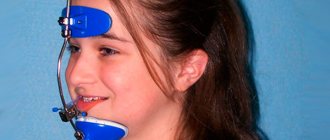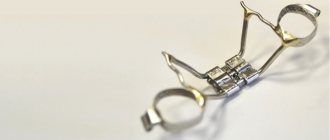A good replacement for braces are teeth straightening aligners made of elastic material. From this article you will learn about the differences between the design and braces and its effectiveness.
Aligners are removable orthopedic structures used in dentistry to correct minor defects in the dentition and bite. Outwardly, they are similar to the mouthguards that boxers use to protect their teeth.
For production, elastic materials are used, which form a transparent overlay after melting.
The principle of operation is based on slight pressure from the aligner, as a result of which the alveolar tissue is slightly resorbed.
This allows the tooth to move in the right direction. The pressure force is moderate, so it will not be possible to correct complex malocclusions and uneven teeth using a silicone mouth guard.
Stages of treatment
Treatment of minor malocclusions and crooked teeth with aligners is performed in stages.
- At the first consultation with a doctor, an examination of the oral cavity is performed. Diseases of the teeth and oral mucosa are identified, and various methods are used to eliminate the inflammatory process and caries.
- Next, together with the orthodontist, the type of aligners is selected , after which a treatment plan is developed.
- Impressions are taken from both jaws. The working material is a special mass with a pleasant mint taste. The cast hardens in just a couple of minutes.
- The silicone impression is sent to the dental technician's laboratory , where he makes a plaster model of the aligner. After this, the specialist manually adjusts each tooth.
- The treatment process is divided into stages, for each of them a different aligner model is developed. The number of trays in the set is determined by the complexity of the defect and the anatomical features of the patient’s jaw.
- At a doctor’s appointment, the patient tries on the first aligner and receives recommendations for further use of the aligners, as well as for caring for the structure.
Which method of correcting malocclusion pathologies is preferable?
Considering all the features, advantages and serious differences of corrective systems, the choice of patients predictably falls on mouthguards. But the final decision is made by the orthodontist, based on the clinical case, the nature and complexity of dental anomalies, the individual characteristics of the patient and other factors.
Before starting treatment, the patient undergoes an X-ray examination to accurately identify all pathologies. For a better understanding and choice of the optimal correction technique, it is worth undergoing a 3D scan and planning the future result.
To learn more about orthodontic treatment and find the best solution, call and schedule a consultation!
Contraindications to treatment with aligners
Experts identify a number of restrictions on the use of aligners to correct dental defects. These include:
- destruction of alveolar bone tissue;
- acute periodontal diseases;
- tartar;
- skeletal abnormalities of the jaw;
- TMJ diseases;
- somatic disorders;
- impacted teeth.
The decision to correct a bite with braces is difficult for patients. The main reason is the duration of such treatment and the lack of attractiveness of braces. Using clear aligners to straighten teeth has become the most acceptable option to correct the situation.
At the moment, there are various ways to correct a bite. One of the most modern and effective are aligners for teeth straightening. They are manufactured and selected taking into account the characteristics and wishes of the client.
How long should you wear aligners?
18 hours a day is the optimal minimum wearing time. The total duration of treatment depends on the complexity of the case and in each situation this issue is resolved individually. A good dentist in Moscow familiarizes the patient with all the stages and nuances before installing aligners.
Are there any restrictions when wearing aligners?
With aligners on your teeth, you cannot eat, drink any drinks other than water, or chew gum or candy. It is recommended to avoid contact sports such as boxing or others where there is a risk of injury.
But when the aligners are removed, there are no restrictions: everything depends on the patient’s comfort. You can eat any food, including solid foods, undergo almost all medical and cosmetic procedures (we wrote about this in more detail), and brush your teeth with any brush.
Aligners should be stored in a container, and cleaned with care - there is a risk of breaking them.
An orthodontist can tell you more about all stages of treatment during a consultation. In terms of orthodontic bite correction, each patient has individual characteristics that are identified at the preparation stage. In any case, the entire process of correcting the bite can be seen in advance in the format of a computer model. When choosing aligners, patients know in advance the duration of their treatment and can assess the future result.
Aligners for bite alignment
Aligners are elastic transparent trays that are applied to the entire dentition. They resemble trays used to lighten enamel. The patient can put on and take off the aligners on their own; it doesn’t hurt at all. Unlike braces, they do not need to be worn constantly. The aligners can be removed before eating or brushing your teeth.
You can learn all about them from your orthodontist. The main purpose of aligners is to correct the bite. They apply imperceptible and painless pressure on the teeth, directing them in the desired direction. The main requirement is to wear them at least 18 hours a day. The wearing time may vary if the bite defect is too noticeable and severe. In case of serious disorders, mouth guards must be worn constantly.
Aligners are made from a synthetic transparent material. This makes them almost invisible, which is very important for those who are worried about their smile after installing braces. Also, mouth guards do not require wearing for years.
Typically, aligners are made as a set and given to the patient in several pieces. The doctor will schedule. After some time, one mouth guard is replaced by another.
The material is selected in such a way as not to injure teeth and gums, provoke an allergic reaction or cause discomfort. This is not a scam, this is the optimal solution!
Pros and cons of aligners and braces in use
Comparing aligners and braces allows you to understand the question of which technology is best to choose in your case. Each technology has its own advantages and disadvantages, and for convenience we will summarize them in a table.
| Comparison options | Aligners | Braces |
| Appearance | Transparent aligners | Locks. glued to the teeth, and a metal arch connecting them |
| Color | Transparent | Any |
| Material | Polymer | Metal/Polymer/Ceramics |
| Allergenicity | No | Yes |
| Are they suitable for children? | No | Yes |
| 3D modeling of jaws on a computer | Yes | No |
| Discussion with the doctor of the result and patient participation in treatment | Yes | No |
| Preparation time | 7 days | 1-2 days |
| Installation time | 45-60 minutes | 3-6 hours |
| Taking impressions before installation | Oral scan + impressions | Yes |
| Treatment speed | 30% faster | Slower |
| Impact mechanics | Simultaneous rotation and displacement of the tooth in the desired direction due to tight coverage | Consecutive displacement in one direction or another and rotation |
| Risk of caries | No | Yes |
| Possibility of enamel remineralization | Yes | No |
| Possibility of injury to the mucous membrane | No | Yes |
| Frequency of visits to the doctor for correction | Every 4-6 weeks | Every 2 weeks |
| Dietary restrictions during treatment | Almost not | Yes |
| Possibility to remove the structure for eating or cleaning | Yes | No |
| Food getting stuck between teeth | No | Yes |
| Bad breath after eating | No | Yes |
| Difficulty in oral hygiene | No | Yes |
| The need to brush your teeth after every meal | No | Yes |
| The need to use dental floss and toothpicks | If necessary | Necessarily |
| Using a special toothbrush | No | Yes |
| Toothbrush lifespan | Standard | Short (due to increased wear) |
| Opportunity to see results before treatment begins | Yes | No |
| Need to be worn constantly | No | Yes |
| Psychological comfort and self-esteem | Yes | No |
| Aesthetics of appearance | High | Low |
| Feeling of discomfort | No | Yes |
| Possibility of pain at the beginning of treatment | No | Yes |
| Impaired diction | Almost not | Yes |
| Protecting teeth from injury | Yes | No |
| Ease of installation and wearing | Yes | No |
| Possibility of self-replacement | Yes | No |
| Possibility of peeling off | No | Yes |
| Disruption of the usual way of life and forms of communication | No | Yes |
As can be seen from the above comparison, aligners are more convenient in almost everything. Braces cause more discomfort, require changes in the usual lifestyle and diet, and, in fact, the only case when braces are preferable is when the patient is a child. Therefore, when choosing between braces or aligners, according to the orthodontist, it is better to prefer aligners.
Popular aligner manufacturers
Aligners are a relatively new invention in dentistry. They began to be actively used in the early 2000s. Initially, they were produced only by an American company, but then other countries began to produce high-quality aligners.
At the moment, the most popular manufacturers of aligners are:
- Star Smile. The price of these mouthguards is not that high since they do not have to be shipped from the USA. The aligners are manufactured in Moscow, but using American technology. The mouthguards are also changed every 2 weeks, the course of treatment is up to 15 months.
- Orthosnap. One of the cheapest aligners. Computer modeling is not used in their manufacture, so it is difficult to judge their effectiveness.
- Clear Correct. These mouth guards are suitable even for those who have very sensitive gums and have a reaction to synthetic materials. They are made in the USA.
- Invisalign. Invisalign appeared on the Russian market earlier than other aligners. Therefore, many dentists prefer to trust this brand. These aligners are usually changed every 2 weeks. They are highly effective, but the price is also quite high.
It is worth clarifying that in the clinic the doctor only takes pictures and modeling. The aligners themselves are manufactured in the country where the manufacturer is located.
Advantages of braces systems
Braces are noticeable on the teeth when smiling and while talking, and this is one of their main disadvantages. They can cause inconvenience and a feeling of embarrassment and require adaptation and careful care. But their effectiveness easily covers these shortcomings. This technique has many advantages:
- braces are more rigid and exert strong pressure on the teeth, increasing the effectiveness of correction and accelerating the result;
- suitable for correcting dental anomalies in complex cases, where aligners are powerless;
- suitable for adults and children.
But even with their high effectiveness, the patient will have to visit the doctor repeatedly and on a regular basis, and treatment can last from several months to several years.
To minimize the aesthetic defect during treatment, you can use ceramic, sapphire or ligature braces, which are installed on the inside of the teeth. They are not so noticeable, but it is impossible to completely hide them. In addition, ligature systems may not be used in all clinical cases.
When wearing braces, you will have to comply with serious dietary restrictions. It is necessary to avoid or minimize the presence in the diet of foods that are too hard, hard and stick to the teeth.
Braces require more careful oral hygiene. The patient needs to brush not only his teeth, but also scrupulously clean all structural elements where food particles may become clogged. Otherwise, plaque will be deposited in hard-to-reach places and cause bad breath, the development of dental diseases, and caries.
Operating principle of the devices
For one course of corrective therapy, several copies of trays are made, each of which differs in minor changes in the positioning of dental units. The number of sets (from 10 to 40) and the step of geometric parameters are calculated on a computer using special software, which calculates distances and angles of movement with perfect accuracy.
The essence of corrective therapy with aligners is to create constant soft physical pressure, which forces the dental elements to move in a given direction. The bone tissue dissolves in the direction of the impact, the teeth move a little, and where they were before, new bone tissue is formed.
As intermediate stages are completed, the patient himself changes the aligners in strict accordance with the numbering of the copies.
Caring for braces and aligners
If you still haven’t decided what to prefer, aligners or braces, and considering their pros and cons, pay attention to the simple rules of care in relation to transparent aligners. Experts recommend removing them from the mouth after each meal, rinsing thoroughly with water and cleaning with a brush. They have a polished surface that is not prone to deposits. In turn, due to the absence of sharp elements, it is possible to prevent the accumulation of food particles. However, there is one undesirable point - the high probability of plastic staining when drinking coffee and tea.
As for traditional braces, they are much more difficult to clean. Particles of solid food may accumulate under the arch and in the area of the locks, which indicates the need to use special brushes, brushes and dental floss. In the absence of proper hygiene, deposits can provoke the appearance of carious lesions.
Consequences of malocclusion
When postponing orthodontic treatment, a person should understand what health problems a malocclusion can cause. Not only an unsightly smile or facial asymmetry, which can be ignored, but also gastrointestinal pathologies, poor posture, and joint pain. The oral cavity is the initial link in the digestive system.
Therefore, we can highlight the most likely consequences of malocclusion:
- Pathological processes in the oral cavity. The non-anatomical arrangement of units leads to disruption of the distribution of chewing load, abrasion of the surface layer of enamel and the formation of caries. In severe clinical cases, inflammatory processes in the gums may develop, which will lead to tooth loss.
- Gastrointestinal diseases. Impaired jaw closure prevents the food bolus from forming correctly when chewing food, which can cause diseases of the digestive system (gastritis, reflux, heartburn).
- Diseases of the ENT organs. A type of dental pathology - an open bite leads to breathing through the mouth, which causes the mucous membranes of the nasopharynx to dry out. This creates excellent conditions for the life of bacteria and the development of inflammation in the respiratory tract.
- Asymmetry of facial features. The predominance in size of one of the jaws, or its underdevelopment, leads to a violation of the proportions of the face. The chin may protrude strongly forward or the profile may be flat.
- TMJ pathologies. Increased chewing load on incorrectly positioned units due to occlusion pathology has a great impact on the joint. There is pain when opening the mouth and clenching the jaws, and clicking sounds when chewing food. Without proper treatment of malocclusion, taking into account the functioning of the joint, arthritis, ankylosis and fibromyalgia can develop.
- Speech therapy disorders. Incorrect position of teeth and jaws in relation to each other, disturbances in the closure of lips - all this interferes with the correct pronunciation of sounds. It influences correct speech perception and general literacy.
Some complications accumulate from childhood, but only appear many years later (in older age) (such as joint pain, gastrointestinal diseases). Orthodontic therapy should be started as early as possible and not wait for unpleasant complications to arise. If you suspect crowding of units or a difference in the size of the jaws, you must immediately make an appointment with a specialist. Correction of bite in adults is possible using various techniques that are suitable specifically for their clinical case, age and financial capabilities .
Get a consultation
We will answer all your questions before visiting the clinic!
+7
Online registration
Orthodontic plates for teeth
Orthodontic plates are devices that combine plastic and metal. The base of the structure is made of plastic and is fixed on the palate or gum under the tongue, and metal guides work with the teeth. Also, some plates have an additional built-in specialized screw, which is responsible for expanding the jaw or extending the segment.
Plate operation . Orthodontic plates can:
- Move specific units. The arches tend to return to their original position, therefore, as in braces, putting pressure on the units moves them.
- Change the width of the dentition and palatine bone. A special key is used to rotate the screw built into the plate. With each rotation of it, the plate expands, which leads to rupture of the palatal suture and the formation of additional space in the dentition. Thus, an incorrectly erupted tooth can fall into place.
- Adjust the height of jaw closure. With a deep bite, plastic parts of the plate are placed on the chewing group of teeth, which help to raise the bite and create space for the growth of other units.
Plates in orthodontic practice are mainly used in the treatment of children with primary occlusion, when the jaw bones are still growing and respond well to therapy. It turns out to be very effective in preventing the formation of jaw pathologies. In adult patients, plates can be used in the retention period, at the end of treatment, to maintain the achieved result.
Varieties. There are removable and non-removable plates that are used for the upper and lower jaw:
- with a hand-shaped process – corrects the position of individual units or groups of teeth;
- with a retraction arch – alignment of the entire dentition;
- Andresen-Goipl activator - a two-jaw removable device that avoids the formation of defects at the stage of primary occlusion;
- The Marco Ross apparatus is a non-removable structure that is fixed to the sixes with rings and expands the jaw with a screw. This provides space for the molars.
- Frenkel apparatus is a complex system of four types with additional accessories for correcting malocclusion.
- Bruckle apparatus – corrects anomalies in the position of the lower incisors.
Pros: reasonable cost of equipment, ability to remove plates if necessary, standard oral hygiene, correction of jaw abnormalities at an early age.
Minuses. Plates do not correct the bite completely, but only individual anomalies. If you want to achieve a perfect smile, you will need to install braces.
Price. The cost of manufacturing a device with fixation in the oral cavity starts from 5 thousand rubles, but varies depending on the purpose and design of the device.
Trainers for teeth straightening
Orthodontic trainers – silicone mouth guards for correcting malocclusion in adults. At the start of therapy, soft pads are used for comfortable adaptation, which are later replaced with harder ones for effective correction.
Mouthguards can only work at night during sleep, because it is impossible to eat, drink, or speak in them. During the day, the device is worn for 1-2 hours.
Such equipment can correct minor defects in the bite, as well as correct the position of the tongue, normalize nasal breathing and swallowing.
Pros. The mouthguards are standardized sizes, there is no need for individual adjustments. They do not affect appearance and social life, because they are used at night. They are easy to care for - brush your teeth at night, and the mouthguard should be rinsed under running water.
Minuses. They cannot correct severe pathologies, and the correction of small defects takes a long period of time.
Price: from 2 thousand rubles.
It turns out that correcting the bite in adults without braces, namely with trainers, is possible only with minor violations.
Aligners – transparent aligners
Aligners are a set of transparent aligners made according to individual characteristics from impressions of the patient’s teeth. They are made of thin plastic, transparent and show excellent results. At Implantmaster, aligners are an alternative to braces for correcting malocclusion in adults. 3Shape Trios scans the oral cavity (the modern equivalent of taking impressions), and then creates a 3D model of all the movements of the units to a healthy smile. Such technologies are used only for aligners.
Correction technique. Mouthguards for correcting malocclusion in adults require constant wearing, and they can only be removed before eating and brushing your teeth. To correct bite anomalies with aligners, it is necessary to replace the aligners every 2 weeks with a new pair.
Positive characteristics of therapy:
- high aesthetics;
- show good results;
- do not cause allergies;
- after 2 days of adaptation they do not affect speech;
- All therapy takes up to 1.5 years.
Minuses. The cost of general treatment with aligners, due to the high cost of replaceable aligners and 3D technologies, is very high. Frequent visits to a specialist are also necessary for correction and obtaining a new set of aligners.
Price. Aligners for correcting malocclusion in adults will cost 350 thousand rubles at Implantmaster.
Indications for use. Correction of minor violations of the arrangement of units and the retention period after completion of treatment on the brace system to maintain the result.
Effective models
In their practice, specialists from our network of clinics use orthodontic aligners that meet the following requirements:
- high impact efficiency;
- harmlessness to human health;
- Positive assessment from patients and orthodontists
Many types of aligners meet these requirements, but the following models are especially popular:
- Invisaling (USA) - made to individual sizes from thin polymer, practically invisible to a prying eye. The advantage is that it can be used from the age of 8;
- FlexiLigner - effective in difficult cases: open and cross bites, dystopia (deviation from the correct growth vector), rotation (rotation).
- KidsLight - this line is a modification of the FlexiLiner brand for children over 5 years old.
Our clinic
Dentistry "Implantmaster"
5.0 – 79 reviews
- Maly Sukharevsky Lane, 9, building 1, Moscow 115280
- Tsvetnoy Boulevard
- Pipe
- Sukharevskaya
- Mon-Sat: from 09:00 to 21:00; Sun: Closed
More details
Sign up for a consultation
Correcting the bite surgically
The absolute indications for the intervention of maxillofacial surgeons are the consequences of a pathological bite that affects the health of the body.
- Difficulty chewing food, swallowing and breathing.
- Pathological conditions of the TMJ.
- Chlo injuries.
Also, such types of pathological occlusion as mesial and distal, in some cases in adult patients, will not be completely corrected with braces. Surgery will be required to improve facial signs.
To correct the bite in adults, plastic surgery of the jaw bones is performed using surgery: tissue expansion or elimination of excess. This technique is always accompanied by additional treatment using devices (plates, braces) after surgery.
Pros. Corrects bite pathologies of any complexity.
The disadvantages are:
- traumatic;
- long rehabilitation time;
- a large number of restrictions.
But such serious disadvantages are compensated by achieving high-quality and stable results.
Using veneers
Veneers and lumineers are orthopedic onlays made of porcelain, ceramic or composite material. Correction of the bite in adults without braces will not happen with the help of veneers, but a certain masking of defects is possible.
Veneers and lumineers differ in the thickness of the plate walls. Veneers are up to 0.6 mm thick and the tooth enamel underneath must be ground off before being fixed. Lumineers are no larger than 0.3 mm and are fixed directly to the tooth without grinding, but are ineffective on large units.
Patients often wonder about correcting their bite with such overlays. Yes, they look aesthetically pleasing and have the same hygiene as your own teeth. However, it is impossible to correct the bite with veneers or lumineers, only to disguise it.
The main task of the overlays:
- align the shape and height of units in the smile area;
- hide, if any, discrepancy between the shades of fillings and enamel;
- mask interdental spaces and defects in enamel.
With the help of such orthodontic structures, you can give your smile a certain aesthetics and make it even. They last a long time, and with careful oral care they can last up to 20 years.
Correction (masking) of a bite in adults at a price will depend on the number of overlays. One such design will cost around 30 thousand rubles.
Orthodontic treatment and basic devices
As you know, orthodontists are involved in identifying, eliminating and preventing dental anomalies. In their opinion, regardless of the patient’s age, there is always the opportunity to move the tooth to the right place, as well as to stimulate or inhibit the development of the bone structures on which the teeth are attached. This is due to the compliance of the supporting-retaining apparatus.
There are several ways to perform orthodontic treatment, namely:
- Conservative therapy. It consists of using special devices: braces, transparent aligners, thin overlays on teeth, etc.;
- Surgical intervention. This method is used in difficult situations when it is not possible to eliminate the defect using orthodontic appliances. However, a prerequisite after surgery is the use of braces or transparent aligners.
To understand what is better to choose after surgery - aligners or braces - you should pay attention to the following criteria.
Get a consultation
We will answer all your questions before visiting the clinic!
+7
Online registration
Content
1 Consequences of malocclusion
2 Correction of bite after 30 years
3 Modern methods of correcting bites in adults 3.1 Correcting bites with braces
3.2 Orthodontic plates for teeth
3.3 Trainers for teeth straightening
3.4 Aligners – transparent aligners
3.5 Correction of the bite surgically
3.6 Use of veneers
4 The price of bite correction at the Implantmaster clinic
What is cheaper – braces or aligners?
Consultation with an orthodontist
- X-ray panoramic image
- Oral examination
- Drawing up a treatment plan with costs
Price : 2,000 ₽
*if treatment continues in the clinic according to the plan, the consultation is not paid
| Self-ligating metal braces Damon Q | from 250,000 ₽ |
| Self-ligating ceramic braces Damon Clear | from 250,000 ₽ |
| Aligners - trays for straightening teeth | from 350,000 ₽ |
If you are wondering what to prefer - aligners or braces - price is not always the main selection criterion. In some cases, the cost of treatment with standard orthodontic systems and transparent aligners can be the same. For example, if we are talking about the use of sapphire or ceramic bracket systems, the prices for them are considered identical to aligners. Ligature devices made of metal are considered more affordable in cost.
There are differences in payment procedures:
- A set of transparent trays necessary for the complete correction process is manufactured at a time. After this, they are transferred to the patient. The need to visit a specialist is present only once every two months - for consultation.
- If you use traditional braces, at each return visit to the orthodontist you will need to pay an additional fee for replacing certain elements.
In turn, a negative point when treating with transparent aligners is the increased likelihood of damage or loss. Sometimes there is a need to replace them - in case of significant cracks or a noticeable change in shade. Braces are also susceptible to fractures. Often, carious lesions may appear under such devices, which requires additional treatment costs.
In Implantmaster dentistry, the cost of installing transparent aligners has a lower limit of 350 thousand rubles. When fixing ceramic or metal braces in our clinic, you will have to pay from 250 thousand rubles.
Indications and prohibitions for occlusion correction using aligners
What defects are treated with mouth guards:
- tilting or turning of teeth;
- non-critical pathologies of occlusion;
- crowded arrangement of dental elements or, on the contrary, large gaps between them.
Contraindications for installation:
- periodontal disease in the acute phase;
- mental illness;
- the presence of impacted (formed, but not erupted) dental units;
- jaw anomalies.
Indications and contraindications are identified by the dentist at a consultation after visual and hardware diagnostics. Our dental centers are equipped with all the necessary equipment to perform diagnostic and therapeutic procedures.











